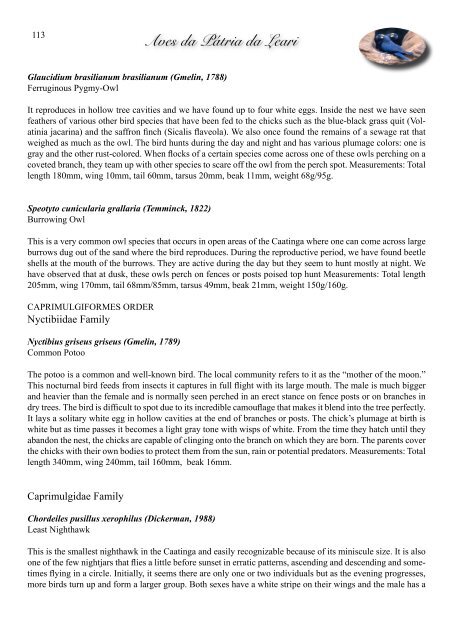Aves da Pátria da Leari - Sociedade Brasileira de Ornitologia
Aves da Pátria da Leari - Sociedade Brasileira de Ornitologia
Aves da Pátria da Leari - Sociedade Brasileira de Ornitologia
Create successful ePaper yourself
Turn your PDF publications into a flip-book with our unique Google optimized e-Paper software.
113<br />
<strong>Aves</strong> <strong>da</strong> <strong>Pátria</strong> <strong>da</strong> <strong>Leari</strong><br />
Glaucidium brasilianum brasilianum (Gmelin, 1788)<br />
Ferruginous Pygmy-Owl<br />
It reproduces in hollow tree cavities and we have found up to four white eggs. Insi<strong>de</strong> the nest we have seen<br />
feathers of various other bird species that have been fed to the chicks such as the blue-black grass quit (Volatinia<br />
jacarina) and the saffron finch (Sicalis flaveola). We also once found the remains of a sewage rat that<br />
weighed as much as the owl. The bird hunts during the <strong>da</strong>y and night and has various plumage colors: one is<br />
gray and the other rust-colored. When flocks of a certain species come across one of these owls perching on a<br />
coveted branch, they team up with other species to scare off the owl from the perch spot. Measurements: Total<br />
length 180mm, wing 10mm, tail 60mm, tarsus 20mm, beak 11mm, weight 68g/95g.<br />
Speotyto cunicularia grallaria (Temminck, 1822)<br />
Burrowing Owl<br />
This is a very common owl species that occurs in open areas of the Caatinga where one can come across large<br />
burrows dug out of the sand where the bird reproduces. During the reproductive period, we have found beetle<br />
shells at the mouth of the burrows. They are active during the <strong>da</strong>y but they seem to hunt mostly at night. We<br />
have observed that at dusk, these owls perch on fences or posts poised top hunt Measurements: Total length<br />
205mm, wing 170mm, tail 68mm/85mm, tarsus 49mm, beak 21mm, weight 150g/160g.<br />
CAPRIMULGIFORMES ORDER<br />
Nyctibii<strong>da</strong>e Family<br />
Nyctibius griseus griseus (Gmelin, 1789)<br />
Common Potoo<br />
The potoo is a common and well-known bird. The local community refers to it as the “mother of the moon.”<br />
This nocturnal bird feeds from insects it captures in full flight with its large mouth. The male is much bigger<br />
and heavier than the female and is normally seen perched in an erect stance on fence posts or on branches in<br />
dry trees. The bird is difficult to spot due to its incredible camouflage that makes it blend into the tree perfectly.<br />
It lays a solitary white egg in hollow cavities at the end of branches or posts. The chick’s plumage at birth is<br />
white but as time passes it becomes a light gray tone with wisps of white. From the time they hatch until they<br />
abandon the nest, the chicks are capable of clinging onto the branch on which they are born. The parents cover<br />
the chicks with their own bodies to protect them from the sun, rain or potential pre<strong>da</strong>tors. Measurements: Total<br />
length 340mm, wing 240mm, tail 160mm, beak 16mm.<br />
Caprimulgi<strong>da</strong>e Family<br />
Chor<strong>de</strong>iles pusillus xerophilus (Dickerman, 1988)<br />
Least Nighthawk<br />
This is the smallest nighthawk in the Caatinga and easily recognizable because of its miniscule size. It is also<br />
one of the few nightjars that flies a little before sunset in erratic patterns, ascending and <strong>de</strong>scending and sometimes<br />
flying in a circle. Initially, it seems there are only one or two individuals but as the evening progresses,<br />
more birds turn up and form a larger group. Both sexes have a white stripe on their wings and the male has a

















